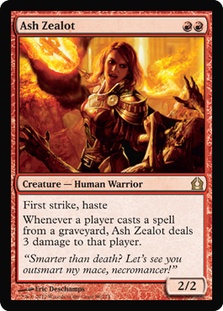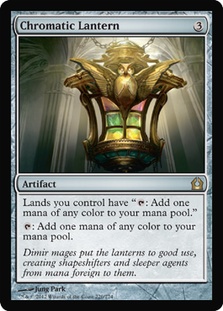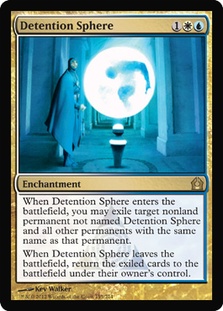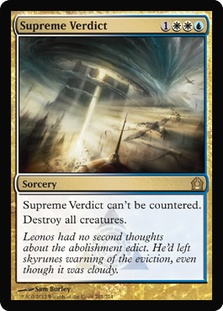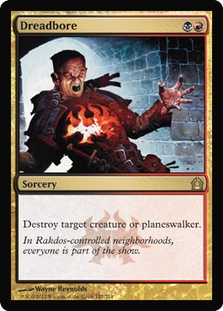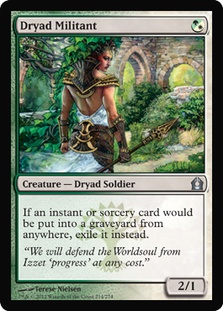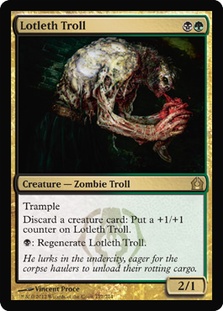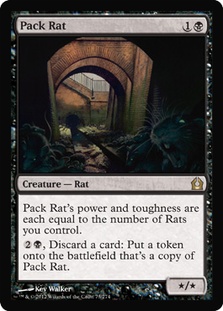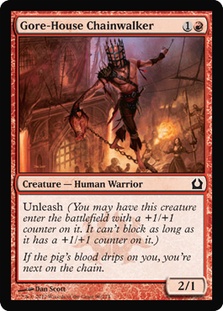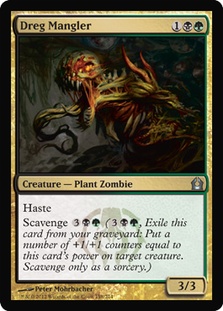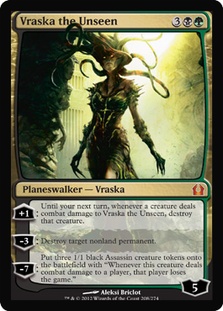With the coming of Return to Ravnica, players will be looking to be adding a ton of new cards to their cubes. When I test cards in my cube, I tend to err on the side of inclusion because the best way of finding out the quality of a card in a cube is to try the cards out. All of the cards that I’m trying out won’t end up making the final cut and may end up in my on-deck binder (or out of consideration) in the long-run, but right now, I am testing more cards from Return to Ravnica than I did for Zendikar.
This is pretty crazy considering how good Zendikar was for cubes. Return to Ravnica’s impact on cubes overall will depend on how multicolor sections are sized since that will determine the threshold of inclusion. I know that many cubes, my own included, will have their multicolor sections expanded to allow the cube to aptly represent the extremely powerful multicolor cards.
In this article, I’ll be discussing ten cards that all cube designers should be highly considering for inclusion in their cubes.
For many years, cube designers and drafters clamored for a two-power two-mana haster in red. Strangleroot Geist showed us that the concept could happen, but it was unfortunately in the wrong color (not that Strangleroot Geist couldn’t make appearances in G/R aggro!). We also saw one in Lightning Mauler, a welcome addition to red aggro decks, but again, it wasn’t always guaranteed to be swinging for two on turn 2, even though the aggro game plan was centered on the one-drop, two-drop curve. Ash Zealot would have been a card cube designers would be happy to include in their cubes with a significant drawback to offset how above the curve a two-power creature with haste and first strike is, but the drawback isn’t even that much of one. If anything, it’s mostly just gravy.
Its secondary ability will be much more of a factor in Constructed formats where the density of cards that get cast from the graveyard is much higher (there are cards in cubes that do interact with it, like Lingering Souls and Faithless Looting, but the density is so low that it won’t be that much of a factor). In fact, you may have some nombos with it. While synergies are very good to have in a cube, you don’t have the luxury of being able to perfectly craft interactions. However, this is fine so long as the cards work towards a cohesive goal. You can have Sulfuric Vortex alongside a Sword of Light and Shadow, Sword of War and Peace, or an Exalted Angel in a R/W aggro shell, but it’s fine because they all work well towards killing the opponent ASAP.
You may have cube decks with Reckless Charge and Gravecrawler alongside Ash Zealot, but don’t let that tarnish your impression of Ash Zealot, as even if it does have some nombos (and there tends to be more red cards with flashback in cubes than in other colors with red having Fire bolt, Reckless Charge, Devil’s Play and Faithless Looting) it still easily mows down early defenders and is really solid with ways to pump it (good luck blocking it once it gets in for two and then gets equipped with Grafted Wargear or Bonesplitter!). If you support red aggro in your cube, Ash Zealot is an easy inclusion for cubes of all sizes.
Scars of Mirrodin block was amazing for artifact sections of cubes, as it helped to tighten up and jettison some of the stragglers which had hung on for many years. Before Scars of Mirrodin block, I would have seen Chromatic Lantern played in every single cube, and because of Scars of Mirrodin block, Chromatic Lantern may have a hard time making it into the smallest of cubes (like at the 360 and under range), but for cubes larger than that Chromatic Lantern is an easy inclusion.
Greedy mana bases can happen a lot in cubes as people enjoy playing three-color or two-color decks and splashing for a few other cards. Coalition Relic may be the best in the business for doing this, but Chromatic Lantern does a very nice job as well. Chromatic Lantern won’t in and of itself make a deck with a few duals suddenly go into Quick and Toast mode, curving from Cryptic Command into Cloudthresher into Cruel Ultimatum, but it does help to make almost anything castable once it resolves (kind of like Gilded Lotus but more focused on enabling casting rather than acceleration).
Another nice thing is that it helps turn utility lands like Library of Alexandria, Mishra’s Workshop, Maze of Ith, and Bazaar of Baghdad into rainbow lands. It’s also particularly useful in blue decks (where it’ll probably see the most play, as blue control decks tend to like their mana rocks) since it can help to activate off-color activation costs. In testing, a blue player who stole a Student of Warfare was able to level it completely because they had Chromatic Lantern. If your cube doesn’t run cards like Signets or Talismans, Chromatic Lantern is another nice card to support mana denial strategies (Pox / Wildfire). All in all, it’s a really solid role-filler. Â
Both of these cards are relatively “boring” cards. WotC took some white staples, made them slightly harder to cast, and added some marginal upside. There will be some matchups where their respective upsides (hitting multiples/being unable to be countered) will be useful, but for the most part, the addition of the blue mana is a drawback and the cost of the blue mana outweighs the upsides. That said, they’re easily staples in U/W sections, even if they’re “boring.”
It can be tempting to dismiss these cards since they’re inferior versions of white (easier to cast) cards, but it’s important to not forget that they’re still awfully close in power to the originals and that they retain much of the raw efficiency of the originals—it just may be harder to cast the U/W ones as optimally. We’re happy to use cards like Chain Lightning, Incinerate, and Searing Spear alongside Lightning Bolt, even if Lightning Bolt is better than the rest.
The only reason that I can see for not using these cards is if you wish to use more diverse cards, but that seems like doing an overall disservice to U/W decks.
In the same vein as Detention Sphere and Supreme Verdict, Dreadbore is an upgrade to an existing card (Terminate). The upside of killing planeswalkers outweighs the downside of instant speed and combining both of those modes makes Dreadbore one of the best B/R cards. Red has ways to indirectly kill planeswalkers through damage/haste creatures, and black doesn’t contribute much outside of Vampire Hexmage. Two-mana creature removal spells with a condition are par for the course in black and adding the ability to kill any creature and planeswalker at the cost of a red mana and sorcery speed is incredibly valuable and retains a lot of efficiency, so Dreadbore is a welcome tool.
It can be tempting to replace Terminate with Dreadbore since Dreadbore does Terminate’s job better, but I don’t think it’s necessarily right to just make that swap. Replacing Terminate with Dreadbore reminds me of when people just replaced Hearth Kami with Torch Fiend once the latter got printed. Hearth Kami is definitely weaker than Torch Fiend at that task, but having Torch Fiend doesn’t suddenly turn Hearth Kami into a bad card—it’s just an easy card to cut when trying to find room (when a better solution may require more work to find). They’re both solid cards and the day may come when you have to cut the weaker one.
I recently did end up cutting Hearth Kami from my cube, but that didn’t really have anything to do with Torch Fiend; it was more the printing of cards like Searing Spear, Lightning Mauler, Flames of the Firebrand and Thundermaw Hellkite. With Return to Ravnica, we have Dreadbore, Terminate, Ultimate Price, and a multitude of other two-mana black spells that kill creatures, but that doesn’t mean that you should throw Terminate out on the curb since it is still a very efficient card, even if it has become a bit less unique and is worse than Dreadbore. Like with the U/W cards, I can see someone not wanting to keep Terminate for diversification reasons, but again, cutting an incredibly efficient removal effect seems like doing a disservice.
Much like Ash Zealot, I would have played Dryad Militant in a heartbeat in my cube without the Snapcaster hosing ability. It has more interactions than Ash Zealot since it prevents anything from entering the graveyard, so even cards like Geralf’s Messenger get hosed hard. However, much like Ash Zealot, the second ability is gravy that can randomly hose an opponent or be a nombo with cards in your deck.*
That said, it’s still a 2/1 for one mana, which is incredibly useful for supporting aggro (and even if you don’t explicitly support green aggro, you definitely should support white aggro). It’s difficult to say whether a card like Dryad Militant is better than the stalwarts like Kitchen Finks and Qasali Pridemage (it likely isn’t), but there’s almost assuredly room in your cube for the Dryad unless your G/W section leans very hard towards midrange strategies.
While Dryad Militant may make it into your cube based on the direction of the G/W section, Rakdos Cackler should easily be in the B/R section of all cubes. Not being able to block is almost a non-existent drawback for aggro creatures (and if you really need a chump blocker, it can be a 1/1), and Cackler’s a card that has a home in black-based, red-based and B/R aggro decks since having a two-power one-mana creature is incredibly useful for the archetype and getting as many efficient ones in cubes is incredibly useful. It’s difficult to say whether Rakdos Cackler is a better card for cubes because both do very different things; I’m tempted to say that the Cackler is due to pure efficiency, but both are definite staples for all cubes.
A lot of quality G/B cards got printed in Return to Ravnica, and out of all of the guilds, Golgari will have its multicolor section affected most by the size of the sections. Its best two cards, Pernicious Deed and Maelstrom Pulse, will remain at the top of the Golgari heap, and they’ll be joined by Lotleth Troll, which is why I’m focusing on the Troll (as it’ll make it into just about every cube that has at least three multicolor cards).
It’s one of the most efficient aggressive creatures that we’ve seen in some time, and it’ll have a home in many B/G decks. Its ability to be pumped combined with trample has made it a royal pain to be blocked in testing (and its trample also makes it great with equipment), it’s a really solid enabler of Reanimation cards and other cards that can get value from the graveyard (it’s downright sick with Squee, Goblin Nabob), and it’s a solid overall beater and regenerator for more traditional G/B midrange decks. It’s been highly played since its inclusion in my cube and is a definite staple.
A lot of the best Izzet cards are pretty clumped together since they perform different tasks quite well (Fire / Ice and Electrolyze kill small creatures well, Prophetic Bolt is a nice value spell), and it’s arguable whether Izzet Charm is better or worse than the old stalwarts. I have been extremely happy with Izzet Charm in testing; in my last article, I talked about how Izzet Charm isn’t particularly efficient at either mode, but its versatility makes it worthwhile and a very solid card. One thing that I didn’t talk as much about is how Izzet Charm’s modes complement each other incredibly well, which helps U/R decks deal with a variety of threats because Izzet Charm is only really bad at dealing with midrange creatures and cheap spells once the opponent has a lot of lands out.
Unfortunately, a lot of the other Charms either face stiff competition (Azorius Charm competition got a lot stronger once Supreme Verdict and Detention Sphere were spoiled and Selesnya Charm, just like Golgari Charm with cards like Abrupt Decay and Vraska, as solid as it is, faces some strong competition from already good G/W cards) or are pretty low on the totem pole (Rakdos Charm). However, Izzet Charm looks like it should be solid in many cubes. I took out Prophetic Bolt for it in my cube, and while Prophetic Bolt may come back in place of Fire / Ice or Electrolyze, Izzet Charm doesn’t look like it’s going anywhere.
The last card that I’ll talk about is a rather odd one which ended up being much better than it initially looked. When I first saw it, it was previewed at the PAX Magic Party in Seattle, and like many, I thought that it was another of the bad Rat cards that cares about other Rats like Plague Rats, Relentless Rats, and Marrow-Gnawer and quickly dismissed it to ogle over cards like Dreadbore. However, it wasn’t until sometime later that people on MTGSalvation’s Cube forum started talking about it. A lot of the early discussion was regarding its interactions with cards that have graveyard shenanigans: Gravecrawler, Bloodghast, Genesis, Squee, Life from the Loam, and Crucible of Worlds, and it looked like a take on the cube-worthy Spellshapers like Waterfront Bouncer.
Due to the fact that Pack Rat makes Clones of itself, it is very difficult to kill with spot removal unless it’s on a turn where the Pack Rat player can’t make a Clone. Usually, that one turn was the only turn at which it could be killed outside of mass removal, and if the opponent didn’t have the Go for the Throat or the Incinerate, usually the opponent got into a rough spot with the Rats. Although it may look like a chump block-creating machine, it’s much better when used for offense. Why? Exponential growth.
Pack Rat has decent stats once you make the first Clone, as you’ve essentially spent two plus three mana and two cards for four power. A curve of going “turn 2 Pack Rat, turn 3 Clone it, attack with the old one for two” is pretty par for the course as you’re attacking with it for twp. Discarding an additional card means that you’ve spent two plus three plus three (eight total) mana and three cards for nine power, which is very good, and once you have three or more Rats on board, that is where the card truly shines since that’s when you start getting really good returns on your mana.
I’m not trying to create a best-case scenario for the card, and admittedly, it can hurt to have one of your three Rats killed because it puts you from having nine power to four, but on the other side of the coin, instant speed removal in testing usually didn’t result in a mid combat blowout like you may expect. Usually, it just slowed down the damage since the Pack Rat player could still curve out easily with the card and the spot removal just stemmed the bleeding.
It’s really solid in black aggro because it gives you a nice resource for dead late game cards (early beaters/lands) while providing additional pressure. In fact, even getting no land after and having a hand of a one-drop, Pack Rat, three lands, and two other cards is fine because you can pretty easily and profitably go “all-in” with Pack Rat and usually that’s a good way to ensure victory. It may not be the best creature to topdeck with an empty hand or a one-card hand, but that was usually outweighed in testing by how well it performed in the other stages of the game.
As I said earlier and as Justin Parnell pointed out in the first part of his Return to Ravnica review, even if you don’t explicitly support black aggro, it’s a very good in other strategies like Reanimator because it lets you dump big creatures into the graveyard for shenanigans later. I’ve been a very big fan of Pack Rat since testing it, and I think it’ll fit right at home in many cubes.
Honorable Mentions
Chainwalker barely missed the cutoff for the ten auto-includes, and Chainwalker will fit into most cubes as red aggro decks want to bash for as much damage as possible and don’t really care about the inability to block. The low toughness is mitigated by being able to cook opposing blockers. It may be hard to fit it alongside Ash Zealot since red has some strong two-drops like Keldon Marauders, but don’t be surprised to see it making its way into many cubes.
I have lumped these cards together as these are all powerful cards which are among the more powerful Golgari cards, but unless your G/B section has seven cards, some of these cards may not make the cut. Like the Fire / Ice, Electrolyze, and Prophetic Bolt package, these cards represent where, as a cube designer, you have the ability to shape and sculpt the direction of your section outside of the staples (Deed, Pulse, and Troll) with each of the cards representing different aspects of the G/B spectrum.
Vraska represents support for the traditional G/B midrange deck, Dreg Mangler represents support for more aggressive decks, and Abrupt Decay leans towards more universal support. Right now, I’m testing Abrupt Decay and Deathrite Shaman due to their universal playability, but their placement in my cube is by no means set in stone. As a cube designer, this suite of cards will give you some wiggle room, but because none of them are on the power level of Deed, Pulse, and Troll, they aren’t cards that you necessarily have to include.
These cards are but a handful of the cube-worthy cards from this set. I hope that this article has given you a baseline of cards that you definitely will want to keep an eye on for your cube.
May all of your opening packs contain Sol Rings!
@UsmanTheRad  on Twitter
http://idratherbecubing.wordpress.com – my blog featuring my cube lists with Return to Ravnica changes!
The Third Power: A Cube podcast featuring myself and Anthony Avitollo!
* I misread Dryad Militant and thought that it exiled everything, but it just targets instants and sorceries. However, the analysis remains the same—it’s still an extremely powerful aggressive creature which has a “gravy” upside of randomly hosing things and some random potential upside/downside depending on the contents of you and your opponent’s deck. It doesn’t stop Reanimation strategies and persist creatures, but it does randomly hose things like flashback. Like Ash Zealot, the Constructed applications of the gravy ability vastly outweigh how it will play out in cubes. At the end of the day, it’s mainly just a 2/1 with a variable upside, but it’s still a staple regardless.
 |
I am Izzet. As a cube designer, I love to relentlessly tinker with the contents of |

